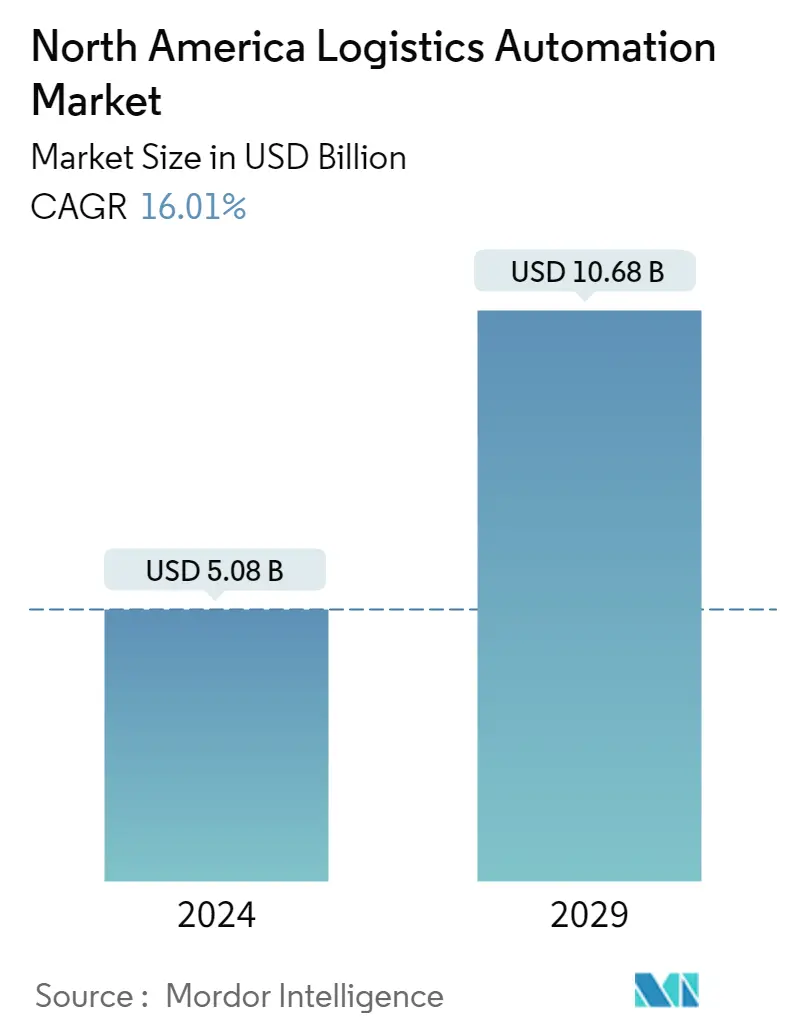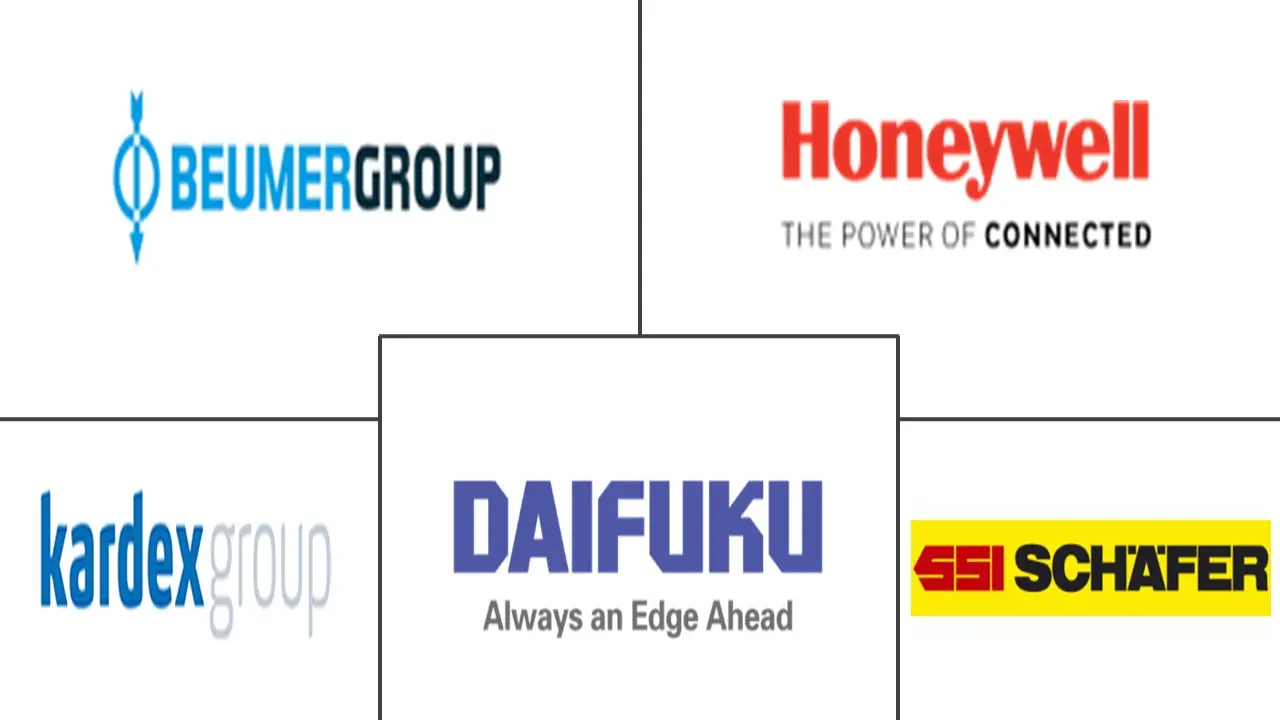Market Size of North America Logistics Automation Industry

| Study Period | 2019 - 2029 |
| Base Year For Estimation | 2023 |
| Market Size (2024) | USD 5.08 Billion |
| Market Size (2029) | USD 10.68 Billion |
| CAGR (2024 - 2029) | 16.01 % |
| Market Concentration | Low |
Major Players
*Disclaimer: Major Players sorted in no particular order |
North America Logistics Automation Market Analysis
The North America Logistics Automation Market size is estimated at USD 5.08 billion in 2024, and is expected to reach USD 10.68 billion by 2029, growing at a CAGR of 16.01% during the forecast period (2024-2029).
The Coronavirus pandemic complicated the situation of automation adoption in logistics sector. By bringing in unique challenges of social distancing and contactless operation it has changed the standard operating procedure and organizations were forced to limit workforce, and deal with the increasing demand. COVID-19 over 2020 and continuing has infected a number of essential workers in the United States, leading companies on the front lines to implement new safety processes. While the spread of the virus has been grave enough to warrant shutdowns for instance, food production facilities, multiple other businesses have been able to continue operations with the addition of new health measures.
- Organizations within the warehousing and trucking industries, when considered, are generally not known as early adopters to automation; in fact, 80% of warehouses globally didn't have any process automation in 2016 as per DHL study.
- Automation in logistics refers to the use of control systems, machinery, and software to enhance the efficiency of operations. It usually applies to the processes performed in a warehouse or distribution center, which requires minimal human intervention. Some of the benefits of automation logistics are improved customer service, scalability and speed, organizational control, and reduced mistakes.
- As per the University of Tennessee, robotics has been one of the most advanced technologies across a supply chain in terms of its proliferation and application. The continued growth in e-commerce and the demand for warehousing services is expected to continue to increase. This is further aligned for acceleration in the segment in order to find cost-reduction solutions through automation.
- The rise of e-commerce has brought a rise in split case orders and even single-unit shipments, which rely much more heavily on automation technologies to be efficient than full-pallet orders. Additionally, an automated storage solution serves an ability to shrink a warehouse's footprint to just 15 percent while increasing productivity.
- As of April 2021, SoftBank Robotics and SB Logistics collaborated with Berkshire Grey to drive innovation in E-Commerce fulfillment operations. Berkshire Grey's robotic pick and pack systems would benefit SB Logistics to process customer orders by robotically handling multiple SKUS in different product categories. SB Logistics' 3PL would use Intelligent Enterprise Robotics solutions, including leading AI-enabled robotic automation solutions to autonomously pick, place, and pack customer orders to best meet the extremely high standards prevalent in the Japanese market. This marks domestic player's expanding in other countries.
North America Logistics Automation Industry Segmentation
Warehouses and distribution centers form the most vital part of the logistics sector. They perform products transit that starts from the process of the production facility, acknowledgment, organizing, and also the tagging for delivering product on the required address.
The Hardware component includes Mobile robots, AS/RS, Conveyor & Sortation Systems, Palletizers, Piece Picking Robots. Whereas, WMS/WCS/WES is also being made part of the study. Further a geographical analysis with the United States and Canada is covered.
| By Solution Type | |||||||
| |||||||
| Software - Warehouse Management Systems (WMS), WES and WCS | |||||||
|
| By Industry | |
| General Merchandise | |
| Apparel | |
| Food and Beverages | |
| Groceries | |
| Post & Parcel | |
| Manufacturing (Durable and Non-Durable) | |
| Other Industries |
| By Country | |
| United States | |
| Canada |
North America Logistics Automation Market Size Summary
The North America logistics automation market is poised for significant growth, driven by the increasing demand for efficiency and speed in supply chain operations. The market is experiencing a transformation as organizations adopt automation technologies to enhance operational efficiency, reduce labor costs, and improve customer service. The rise of e-commerce has further accelerated this trend, with businesses seeking to streamline their warehousing and distribution processes to handle the growing volume of split case orders and single-unit shipments. The COVID-19 pandemic has also acted as a catalyst, prompting companies to implement contactless and automated solutions to maintain operations while adhering to safety protocols. This shift is particularly evident in sectors such as retail, food and beverage, and pharmaceuticals, where the demand for automated logistics solutions is robust.
The United States stands out as a leading market for logistics automation, supported by a strong economy, high e-commerce activity, and significant manufacturing output. The region's logistics sector is witnessing increased investments in automated systems, such as sortation systems, robotic pick and pack solutions, and intelligent enterprise robotics, to meet the demands of a rapidly evolving market. Partnerships and collaborations among key players, such as those between SoftBank Robotics and Berkshire Grey, and Kroger and Ocado, are driving innovation and expanding the capabilities of automated solutions. As companies seek to optimize their operations in response to rising rental costs and limited warehouse space, the adoption of automation technologies is expected to continue its upward trajectory, with major players like Amazon leading the way in integrating advanced robotics into their supply chain operations.
North America Logistics Automation Market Size - Table of Contents
-
1. MARKET INSIGHTS
-
1.1 Market Overview
-
1.2 Industry Value Chain Analysis
-
1.3 Industry Attractiveness - Porter's Five Forces Analysis
-
1.3.1 Bargaining Power of Suppliers
-
1.3.2 Bargaining Power of Consumers
-
1.3.3 Threat of New Entrants
-
1.3.4 Intensity of Competitive Rivalry
-
1.3.5 Threat of Substitute Products
-
-
1.4 Impact of COVID-19 on the Industry Ecosystem
-
1.5 Market Drivers
-
1.5.1 Increased E-commerce Activity
-
-
1.6 Market Challenge
-
1.6.1 High Capital Investment & Nascency Of The Technology
-
-
-
2. MARKET SEGMENTATION
-
2.1 By Solution Type
-
2.1.1 Hardware
-
2.1.1.1 Mobile Robots (Automated Guided Vehicle (AGV) and Autonomous Mobile Robots (AMR))
-
2.1.1.2 Automated Storage and Retrieval System (AS/RS) (Unit Load - Fixed and Movable Aisle, Mini Load, Shuttle & Bot Systems and Other Systems - Carousels and Vertical Lift Modules)
-
2.1.1.3 Conveyor (Belt, Roller, Pallet and Overhead)
-
2.1.1.4 Palletizer/De-palletizer (Conventional - High Level + Low Level, and Robotic)
-
2.1.1.5 Sortation System
-
-
2.1.2 Software - Warehouse Management Systems (WMS), WES and WCS
-
2.1.3 Other Solutions
-
2.1.3.1 Transportation Management Solutions
-
2.1.3.2 Others (Piece-picking robots, collaborative robots, warehouse drones, and supporting infrastructure)
-
-
-
2.2 By Industry
-
2.2.1 General Merchandise
-
2.2.2 Apparel
-
2.2.3 Food and Beverages
-
2.2.4 Groceries
-
2.2.5 Post & Parcel
-
2.2.6 Manufacturing (Durable and Non-Durable)
-
2.2.7 Other Industries
-
-
2.3 By Country
-
2.3.1 United States
-
2.3.2 Canada
-
-
North America Logistics Automation Market Size FAQs
How big is the North America Logistics Automation Market?
The North America Logistics Automation Market size is expected to reach USD 5.08 billion in 2024 and grow at a CAGR of 16.01% to reach USD 10.68 billion by 2029.
What is the current North America Logistics Automation Market size?
In 2024, the North America Logistics Automation Market size is expected to reach USD 5.08 billion.

